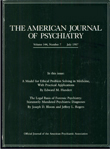Risperidone-Associated Agranulocytosis
Ms. A was a 40-year-old woman who had met DSM-IV criteria for chronic schizophrenia, paranoid type, from the age of 22. She had had no episodes of neutropenia or leu~kopenia, and her WBC count was generally around 5,000/mm3. At admission, her WBC count was 5,600 mm3, and the neutrophil rate was 57%. She was initially treated with chlorpromazine, 300 mg/day, and carbamazepine, 800 mg/day (at therapeutic blood levels), for 6 weeks. Her WBC count gradually fell to 2,500/mm3 and the neutrophil rate to 30%, and treatment was immediately stopped. Her WBC count rose after 2 weeks (5,200/mm3, neutrophil rate=51.7%). Haloperidol (30 mg/day) and lithium (900 mg/day) were then given for 3 weeks. Her WBC count fell again (2,200/mm3, neutrophil rate=52%). Haloperidol was suspended, but lithium was continued for another 5 weeks, along with diazepam (30 mg/day) and trihexyphenidyl (5 mg/day) because of extrapyramidal syndrome, until her WBC count normalized (4,500/mm3, neutrophil rate=53%). Because of Ms. A's psychotic state, treatment with zuclopentixol was started and reached 50 mg/day in the second week; however, zuclopentixol was suspended because of severe extrapyramidal syndrome and a fall in WBC count (2,700/mm3, neutrophil rate=29%). Ms. A developed agitated catatonia, and one course of ECT was administered (three times a week for 2 months), with partial response. Three weeks after zuclopentixol was discontinued and during the course of ECT, her WBC count normalized (4,500/mm3, neutrophil rate=62%). Bone marrow analysis was performed but did not reveal any pathology. Because of her resistant psychotic state and the presence of extra~pyramidal syndrome, risperidone treatment was started 2 weeks afterward and was gradually increased to 4 mg/day in the second week. At that time a blood sample was drawn, and risperidone was discontinued because of the emergence of agranulocytosis (WBC count=2,400/mm3, neutrophil rate=32%).
References
Information & Authors
Information
Published In
History
Authors
Metrics & Citations
Metrics
Citations
Export Citations
If you have the appropriate software installed, you can download article citation data to the citation manager of your choice. Simply select your manager software from the list below and click Download.
For more information or tips please see 'Downloading to a citation manager' in the Help menu.
View Options
View options
PDF/EPUB
View PDF/EPUBGet Access
Login options
Already a subscriber? Access your subscription through your login credentials or your institution for full access to this article.
Personal login Institutional Login Open Athens loginNot a subscriber?
PsychiatryOnline subscription options offer access to the DSM-5-TR® library, books, journals, CME, and patient resources. This all-in-one virtual library provides psychiatrists and mental health professionals with key resources for diagnosis, treatment, research, and professional development.
Need more help? PsychiatryOnline Customer Service may be reached by emailing [email protected] or by calling 800-368-5777 (in the U.S.) or 703-907-7322 (outside the U.S.).

